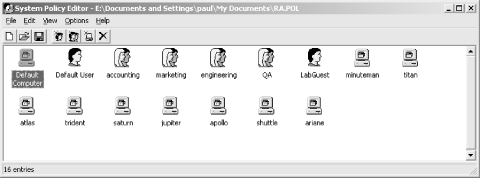|
|
|
6.2 Introducing the System Policy EditorYou create and edit system policies with the System Policy Editor (poledit.exe), which is normally installed only when you install a member of the Windows 2000 or NT server product families. It can be run from Windows 2000 Professional or NT Workstation, though, if you can legally obtain it from a server installation. Don't confuse this version of System Policy Editor with the Windows 95/98 version: if you want to create policies that Win9x clients can use, you must use the Win9x editor, and the same is true for the NT version.[4]
6.2.1 Learning the System Policy Editor InterfaceWhen you use RegEdt32 or RegEdit, you can definitely tell that you're using software that predates Windows 2000. Although both take on some aspects of the Windows 2000 GUI, they're indisputably different from other Windows 2000 software such as Internet Explorer or the system shell. POLEDIT, on the other hand, has an interface very similar to the shell, making it more immediately familiar. The main window for POLEDIT is shown in Figure 6.1. In the figure, each computer, user, or group policy is represented by a large icon. Double-clicking one of these icons opens the associated policy, and policies may be created or deleted from this view as well. Figure 6.1. The System Policy Editor interface 6.2.1.1 Controlling what you seeThe View menu allows you to change POLEDIT 's display in a number of ways, all of which are similar to commands in the shell and other administrative tools. The first
two commands in the menu are window dressing: the View The remaining View menu commands let you change the format of the
display. Unless you change it, POLEDIT displays
policies as large icons; this default corresponds to the
View The settings you choose in the View menu are stored with the policy file, so when you reload a new file it appears as it was when you last had it open. 6.2.1.2 Navigating in the policy windowAs
in Explorer, you can move from item to item in POLEDIT
's window with the arrow, PgUp, PgDn, Home, and End
keys. When a policy is selected, you can open it by double-clicking
it, pressing the Enter key, or using the Edit |
|
|
|